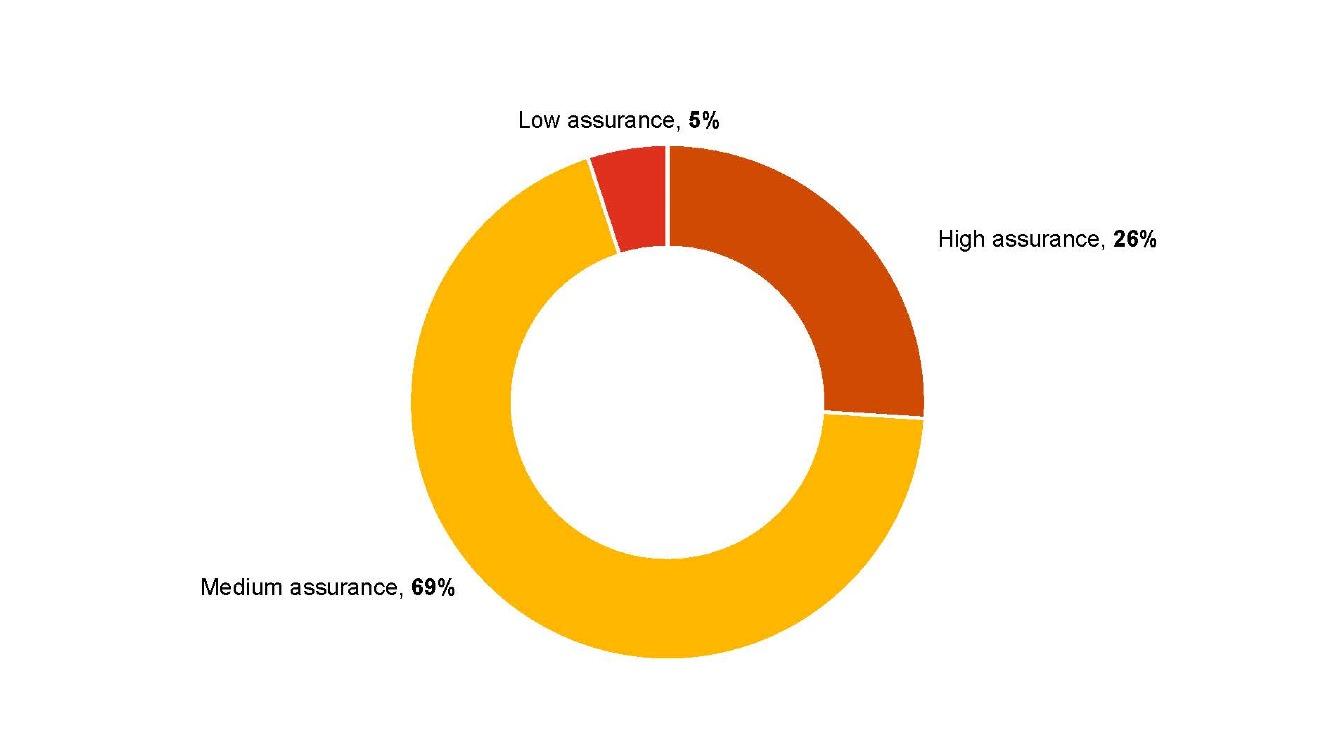
15 December 2022
In brief
The ATO has issued its findings report from Top 1,000 income tax and GST assurance programs completed to 30 June 2022. These findings provide important insights which can be used by taxpayers as a roadmap towards an improved GST assurance rating. Certainly, from a GST perspective, the findings show that more taxpayers are now achieving a medium to high level of assurance.
For the 173 GST assurance reviews completed to the end of June 2022, 26% of taxpayers received a high assurance rating with 69% achieving a medium assurance rating. For 46 the assurance reviews completed in the last 12 months to 30 June 2022 there were improved results with 47% achieving high assurance overall and 50% achieving medium assurance overall.
Overall assurance ratings for all GST assurance reviews completed as of 30 June 2022

Overall GST assurance ratings for all assurance reviews completed in the past 12 months from July 2021 to 30 June 2022

Source: Findings report – Top 1,000 income tax and GST assurance programs, ATO 13 October 2022
One of the key reasons for taxpayers not achieving a high level of assurance is due to a stage 1 rating for GST governance (this rating reflects that you provided evidence to demonstrate a tax control framework exists). A stage 2 rating (which reflects that you provided evidence to demonstrate that a tax control framework exists and has been designed effectively) is a minimum requirement for achieving high assurance overall.
GST governance assurance ratings for all GST assurance reviews completed up to 30 June 2022

GST governance assurance ratings for assurance reviews completed in the past 12 months from July 2021 to June 2022

Source: Findings report – Top 1,000 income tax and GST assurance programs, ATO 13 October 2022
In detail
Importantly, the ATO’s findings arm taxpayers with key insights and information about how to achieve a higher level of assurance. Central to this is being able to provide objective evidence that an effective GST control framework exists and that key GST risk areas are appropriately managed.
What can you do to achieve improved assurance outcomes?
Based on the ATO’s findings both in terms of where taxpayers fall short and where they demonstrate best practice, the following are important to have:
- Board level commitment to implementing a well-designed periodic GST control testing plan that covers all the Board Level and Managerial Level controls as outlined in the ATO’s GST guide. Best practice and a stage 3 rating would require evidence that taxpayers have independently tested the operation of the control framework per their periodic GST control testing plan.
- Documented evidence of a process for reporting material matters or risks to the Board which is tailored to GST.
- Documented procedures for identifying and determining whether GST sign off is required for significant transactions and escalation procedures.
- Documented procedures which evidence the controls in place for data including for manual adjustments.
- Evidence of manual controls and automated GST controls built into business systems for the set-up, review and maintenance of tax codes.
- Documented work instructions in place for GST compliance procedures for the preparation, review, and approval of BAS.
- Supporting data analytics for GST compliance procedures such as exceptions reporting and trend analysis.
What particular areas of risk should you review?
From June 2022, the ATO has indicated that it will start to provide assurance ratings for GST risk areas. This will involve an assessment of whether the GST treatment of business activities, including significant and new transactions results in the correct reporting of GST on the BAS. Obtaining a high level of assurance will mean that the ATO is unlikely to contact you again in relation to the matters reviewed. Preparation beforehand can therefore mitigate the likelihood of prolonged ATO engagement.
Identified risk areas where a GST health check would be recommended include:
Financial supplies
- Is monthly testing of the Financial Acquisitions Threshold (FAT) undertaken and evidenced?
- Are reduced input tax credits being claimed for ineligible costs?
- Have the reverse charge provisions been correctly applied to cross border transactions?
GST food classification
- Is there a regular review of product master data and is this evidenced?
- Has the GST classification of products been properly reviewed (reliance on a supplier’s classification is insufficient)?
Property
- Has the margin scheme been applied correctly?
- Has the GST classification of residential accommodation and/or commercial residential premises been reviewed?
- Have the requirements for supplies of going concerns been satisfied?
- Have agency issues in relation to who is making the supply been correctly reflected for GST purposes?
- Have adjustment events been properly considered and reported?
Recipient created tax invoices (RCTIs)
- Are valid RCTI agreements in place
- Have RCTIs been issued to the correct supplier?
- Are RCTIs being issued to suppliers who are not GST registered or no longer GST registered?
How else can you prepare?
Data and transaction testing
The ATO has indicated that it will use data and transaction testing in its GST assurance reviews from June 2022. This will be used predominantly for entities that make input taxed supplies.
Undertaking data testing before an ATO review is notified allows for early identification and investigation of potential errors. Where independent testing can be relied upon by the ATO, it can also result in a shorter and less intrusive ATO data review, saving time and effort.
GST Analytical Tool (GAT)
The ATO has indicated that completion of the GAT is integral to their combined assurance reviews going forward and will contribute positively towards the overall GST assurance rating. Therefore, undertaking a GAT in preparation for an ATO review will provide better alignment with ATO better practice and should result in improved outcomes.
A GAT is not intended to be used for entities that make predominantly input taxed supplies.
Next Actions
Where the ATO does identify any areas of concern during their review, they will ordinarily provide recommendations which they will later follow up to see what actions have been taken; or they may consider intervention through ATO next actions, in the form of a GST risk review or audit.
Conclusion
The information and insights provided by the ATO’s findings paves a much clearer path for taxpayers to follow in order to achieve an improved assurance rating. PwC can provide tailored assistance to clients wanting to prepare for an ATO GST Assurance review which is structured and aligned with ATO expectations, including assessing what documentation exists or otherwise should be put in place and/or refined from a GST governance perspective and also looking at which of the industry specific technical issues identified by the ATO may be relevant to clients and assessing whether the historical position(s) adopted is aligned with the views put forward by the ATO.
Based on the results from the last 12 months, it appears that more taxpayers are seeing the benefits of following this path not only because it results in a good assurance outcome with the ATO but because a robust GST governance framework can result in improved processes, increased visibility over potential errors and therefore greater ability to mitigate risk or identify opportunities.
For those that don’t follow this path, there is the potential for a rockier road with an increased likelihood of further and/or more frequent ATO engagement.
For more information, please contact the PwC Indirect Taxes team.
Matthew Strauch
Jeff Pfaff
Shagun Thakur
Brady Dever
Mark Simpson
Andrew Howe









